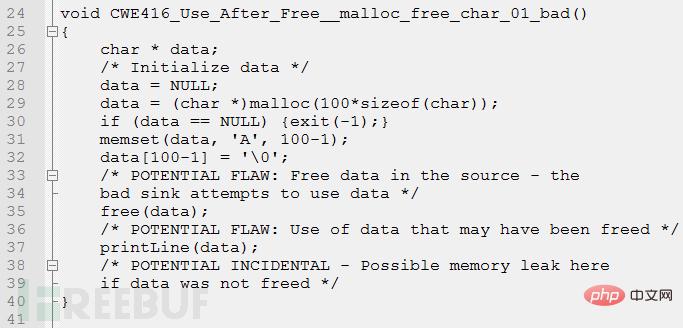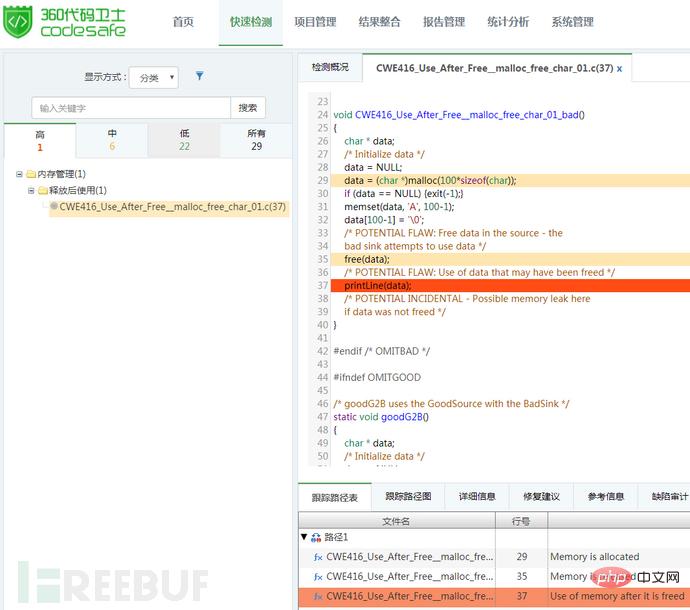 Operation and Maintenance
Operation and Maintenance
 Safety
Safety
 How to implement vulnerability analysis caused by use after release of C++ program
How to implement vulnerability analysis caused by use after release of C++ program
How to implement vulnerability analysis caused by use after release of C++ program
1. Use after release
When dynamically allocated memory is released, the content of the memory is uncertain and may remain intact and accessible, because when it is re- It is the memory manager's decision to allocate or deallocate a freed memory block, but it is possible that the contents of that memory have been changed, causing unexpected program behavior. Therefore, when the memory is released, it is guaranteed that it will no longer be written to or read from.
2. Hazards of use after release
Problems caused by improper memory management are common vulnerabilities in C/C programs. Use after free can lead to potential exploitable risks, including abnormal program termination, arbitrary code execution, and denial of service attacks. From January to November 2018, there were a total of 134 vulnerability information related to it in CVE. Some of the vulnerabilities are as follows:
| Vulnerability Overview | |
|---|---|
| A use-after-free vulnerability exists in the Artifex Mupdf version of fz_keep_key_storable that could lead to a denial of service or code execution issue. The vulnerability could be exploited by tricking a victim into opening a specially crafted PDF file. | |
| There is a use-after-free vulnerability in the HTMLImportsController of the Blink engine in versions prior to Google Chrome 70.0.3538.67, which is likely to lead to remote attacks The author exploits the heap corruption issue through a specially constructed HTML page. | |
| A release exists in Adobe Acrobat and Reader 2018.011.20063 and earlier versions, 2017.011.30102 and earlier versions, 2015.006.30452 and earlier versions Later use of vulnerabilities. A remote attacker could exploit this vulnerability to execute arbitrary code. |
3. Sample code
The example comes from Samate Juliet TestSuite for C/C v1.3 (https://samate .nist.gov/SARD/testsuite.php), source file name: CWE416_Use_After_Free__malloc_free_char_01.c.3.1 Defect code


3.2 Repair code


4, how to avoid using after release
To avoid using after release, you need to pay attention to the following points:(1) Be sure to set a null pointer when releasing memory. Although this method has limited effectiveness for utilizing multiple or complex data structures, But some problems can be avoided to a certain extent. (2) When allocating or releasing memory in a loop statement, you need to carefully confirm whether there is a problem. (3) Use source code static analysis tools for automated detection, which can effectively discover post-release usage issues in the source code.
The above is the detailed content of How to implement vulnerability analysis caused by use after release of C++ program. For more information, please follow other related articles on the PHP Chinese website!

Hot AI Tools

Undresser.AI Undress
AI-powered app for creating realistic nude photos

AI Clothes Remover
Online AI tool for removing clothes from photos.

Undress AI Tool
Undress images for free

Clothoff.io
AI clothes remover

Video Face Swap
Swap faces in any video effortlessly with our completely free AI face swap tool!

Hot Article

Hot Tools

Notepad++7.3.1
Easy-to-use and free code editor

SublimeText3 Chinese version
Chinese version, very easy to use

Zend Studio 13.0.1
Powerful PHP integrated development environment

Dreamweaver CS6
Visual web development tools

SublimeText3 Mac version
God-level code editing software (SublimeText3)

Hot Topics
 What is the role of char in C strings
Apr 03, 2025 pm 03:15 PM
What is the role of char in C strings
Apr 03, 2025 pm 03:15 PM
In C, the char type is used in strings: 1. Store a single character; 2. Use an array to represent a string and end with a null terminator; 3. Operate through a string operation function; 4. Read or output a string from the keyboard.
 Four ways to implement multithreading in C language
Apr 03, 2025 pm 03:00 PM
Four ways to implement multithreading in C language
Apr 03, 2025 pm 03:00 PM
Multithreading in the language can greatly improve program efficiency. There are four main ways to implement multithreading in C language: Create independent processes: Create multiple independently running processes, each process has its own memory space. Pseudo-multithreading: Create multiple execution streams in a process that share the same memory space and execute alternately. Multi-threaded library: Use multi-threaded libraries such as pthreads to create and manage threads, providing rich thread operation functions. Coroutine: A lightweight multi-threaded implementation that divides tasks into small subtasks and executes them in turn.
 How to calculate c-subscript 3 subscript 5 c-subscript 3 subscript 5 algorithm tutorial
Apr 03, 2025 pm 10:33 PM
How to calculate c-subscript 3 subscript 5 c-subscript 3 subscript 5 algorithm tutorial
Apr 03, 2025 pm 10:33 PM
The calculation of C35 is essentially combinatorial mathematics, representing the number of combinations selected from 3 of 5 elements. The calculation formula is C53 = 5! / (3! * 2!), which can be directly calculated by loops to improve efficiency and avoid overflow. In addition, understanding the nature of combinations and mastering efficient calculation methods is crucial to solving many problems in the fields of probability statistics, cryptography, algorithm design, etc.
 distinct function usage distance function c usage tutorial
Apr 03, 2025 pm 10:27 PM
distinct function usage distance function c usage tutorial
Apr 03, 2025 pm 10:27 PM
std::unique removes adjacent duplicate elements in the container and moves them to the end, returning an iterator pointing to the first duplicate element. std::distance calculates the distance between two iterators, that is, the number of elements they point to. These two functions are useful for optimizing code and improving efficiency, but there are also some pitfalls to be paid attention to, such as: std::unique only deals with adjacent duplicate elements. std::distance is less efficient when dealing with non-random access iterators. By mastering these features and best practices, you can fully utilize the power of these two functions.
 How to apply snake nomenclature in C language?
Apr 03, 2025 pm 01:03 PM
How to apply snake nomenclature in C language?
Apr 03, 2025 pm 01:03 PM
In C language, snake nomenclature is a coding style convention, which uses underscores to connect multiple words to form variable names or function names to enhance readability. Although it won't affect compilation and operation, lengthy naming, IDE support issues, and historical baggage need to be considered.
 Usage of releasesemaphore in C
Apr 04, 2025 am 07:54 AM
Usage of releasesemaphore in C
Apr 04, 2025 am 07:54 AM
The release_semaphore function in C is used to release the obtained semaphore so that other threads or processes can access shared resources. It increases the semaphore count by 1, allowing the blocking thread to continue execution.
 Issues with Dev-C version
Apr 03, 2025 pm 07:33 PM
Issues with Dev-C version
Apr 03, 2025 pm 07:33 PM
Dev-C 4.9.9.2 Compilation Errors and Solutions When compiling programs in Windows 11 system using Dev-C 4.9.9.2, the compiler record pane may display the following error message: gcc.exe:internalerror:aborted(programcollect2)pleasesubmitafullbugreport.seeforinstructions. Although the final "compilation is successful", the actual program cannot run and an error message "original code archive cannot be compiled" pops up. This is usually because the linker collects
 C and System Programming: Low-Level Control and Hardware Interaction
Apr 06, 2025 am 12:06 AM
C and System Programming: Low-Level Control and Hardware Interaction
Apr 06, 2025 am 12:06 AM
C is suitable for system programming and hardware interaction because it provides control capabilities close to hardware and powerful features of object-oriented programming. 1)C Through low-level features such as pointer, memory management and bit operation, efficient system-level operation can be achieved. 2) Hardware interaction is implemented through device drivers, and C can write these drivers to handle communication with hardware devices.





